Use 'Print preview' to check the number of pages and printer settings.
Print functionality varies between browsers.
Printable page generated Sunday, 30 November 2025, 8:26 PM
Adolescent and Youth Reproductive Health Module: 5. Harmful Traditional Practices (HTPs)
Study Session 5 Harmful Traditional Practices (HTPs)
Introduction
In this study session, you will learn about traditional practices that can be harmful to young people’s sexual and reproductive health. These practices include; female genital mutilation, early marriage, marriage by abduction, and polygamy. You will also learn some of the reasons that are given to explain why communities practise these harmful acts and what you can do to minimise or eliminate harmful traditional practices in your community.
Learning Outcomes for Study Session 5
When you have studied this session, you should be able to:
5.1 Define and use correctly all of the key words printed in bold. (SAQs 5.1 and 5.2)
5.2 Describe common harmful traditional practices (HTPs) and the consequences they have for sexual and reproductive health. (SAQs 5.1 and 5.2)
5.1 Harmful traditional practices (HTPs)
Traditions are long-established patterns of actions or behaviours, often handed down within a community over many generations. These customs are based on the beliefs and values held by members of the community. Traditions are often protected by taboos, which are strong social prohibitions (or bans) relating to human activity or social custom based on moral judgement and religious beliefs. This means that traditions are not easy to change, because people adhere to these patterns of behaviour, believing that they are the right things to do. Ethiopia has both beneficial traditional practices (such as breastfeeding, relieving women from work after delivery, providing special care and a nutritious diet for a newly delivered mother) and harmful traditional practices.
Harmful traditional practices are those customs that are known to have bad effects on people’s health and to obstruct the goals of equality, political and social rights and the process of economic development.
Harmful traditional practices affecting young people in Ethiopia are very common. Among these, female genital mutilation (FGM), early marriage, and marriage by abduction, forced marriage and polygamy are particularly important for you to understand because of their effect on reproductive health. Examples of other which we will not discuss here because they are not very much related to reproductive health include uvulectomy (excision of the uvula), bloodletting through vein puncture (called wagemt in Amharic), and milk tooth extraction.
5.1.1 Female genital mutilation (FGM)
The World Health Organization (WHO) defines female genital mutilation (also called ‘female genital cutting’ or ‘female circumcision’) as any procedure which involves the partial or total removal of the external female genitalia (see Figure 5.1) or which causes any other injury to the female genital organs whether for cultural or any other non-therapeutic reasons. Instruments used include knives, scissors, razors, and pieces of glass. Occasionally sharp stones and cauterisation (burning) are used.
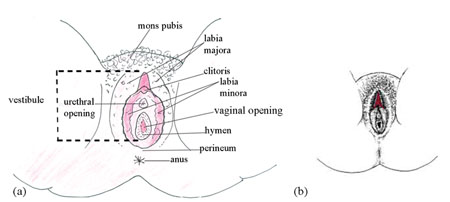
FGM has no known benefits; instead, it can have both short- and long-term bad consequences for health.
Thinking about the instruments that are used, suggest one short-term bad physical consequence of FGM.
An immediate physical effect of FGM might be bleeding and injury to nearby genital tissue. Since FGM is usually conducted under unhygienic circumstances, it may also result in tetanus or sepsis (bacterial infection) developing very soon.
In the long term, FGM can cause repeated recurrent urinary tract infections, increased risk of childbirth complications and newborn deaths and the need for later surgery. For example, the FGM procedure that seals or narrows a vaginal opening needs to be cut open later in life to allow for sexual intercourse and childbirth. Sometimes it is stitched again several times, e.g. after childbirth, hence the woman goes through repeated opening and closing procedures.
There are often psychosocial consequences of FGM (see Box 5.1).
Box 5.1 Consequences of FGM
Short-term physical consequences
- Severe pain (see Case Study 5.1)
- Injury to the adjacent tissue of urethra, vagina, perineum and rectum
- Bleeding
- Infection
- Failure to heal.
Long-term physical consequences
- Difficulty in passing urine
- Recurrent urinary tract infection
- Difficulties in menstrual flow
- Fistula.
Psychosocial consequences
- Mutilation is an occasion marked by fear, and the suppression of feelings. More often the bad memory never leaves the victims.
- Some women report that they suffer pain during sexual intercourse and menstruation.
- The experience is associated with sleeplessness, nightmares, loss of appetite, weight loss or excessive weight gain.
- As they grow older, women may develop feelings of incompleteness, loss of self-esteem/confidence, and depression/sadness.
Now read Case Study 5.1.
Case Study 5.1 Almaz
Almaz is a seven-year-old living in Southern Ethiopia. Her parents have decided that she will be ‘circumcised’ because they believe that without it, she won’t be married (Figure 5.2). They believe it is a kind of ‘cleaning’. No one has explained to Almaz exactly what will happen to her on the day of her circumcision. Abebech, a 65-year-old known traditional practitioner, used a new razorblade to cut her genitalia. The practitioner needed six women to hold Almaz down.
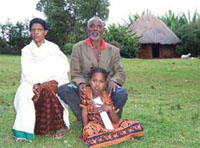
Almaz almost lost consciousness because of the pain, and shortly after the procedure she was taken to her parents as she was not able to walk on her own.
Stop reading for a moment. Have you yourself experienced FGM or do you know someone in your village who has undergone the same procedure? If so, what are the reasons for it? What is the usual age at which girls undergo FGM in your community? What roles can you play to stop the practice?
Although FGM is recognised as a violation of human rights under Ethiopian law, it continues to be practised in many regions of Ethiopia. A study in 2005 indicated that three in four Ethiopian women aged 15–49 had undergone some form of FGM.
The age at which girls are made to undergo FGM varies from region to region. In Amhara and Tigray, for example, FGM is performed at infancy, usually on the eighth day after birth. In Somalia, Afar and Oromia, girls are subjected to FGM between the ages of seven and nine, or just before marriage between the ages of 15 and 17. According to the same study (in 2005), FGM is highest in Afar, where 85% of women have a daughter with genital mutilation, and lowest in Gambela, where 11% of women have a daughter with mutilation. It is a shocking measure of deep-rooted gender inequality that one in three rural women believes that the practice should continue.
There are a variety of reasons why FGM continues to be practised. You have already reflected on the reasons that are given for FGM in your community. Box 5.2 gives reasons that are commonly reported.
Box 5.2 Reasons given by communities for practising FGM
- Sociocultural reasons: in some communities, FGM is believed to ensure a girl’s virginity and thereby her family’s honour, because virginity is often a prerequisite for marriage.
- Psychosexual reasons: in some communities the unexcised girl is believed to have an overactive and uncontrollable sex drive which makes her likely to lose her virginity prematurely, disgracing her family and damaging her chances of marriage.
- Spiritual and religious reasons: for some communities, removing the external genitalia is necessary to make a girl spiritually clean and is therefore required by religion. Muslims who practise FGM tend to believe that it is required by the Koran. However, FGM is not mentioned in the Koran.
- Hygienic and aesthetic reasons: in some cultures, woman’s external genitalia are considered as ugly and dirty and removing these parts of the external genitalia is believed to make girls hygienically clean.
It is important to note that all the above reasons for practicing FGM are based on false beliefs that FGM has advantages for the girls and their community. You will learn and teach others that none of these reasons are true. In fact, FGM harms women’s sexual and reproductive health. In particular it can cause difficulties during childbirth.
As a health worker, you need to acknowledge the fact that it is not easy to change such a tradition when it has been believed by many generations of people in your community. That is why it needs constant teaching and society’s support to stop the practice. It is especially helpful if men can accept that it is damaging to their daughters and if the women who perform the procedure can be convinced that it needs to stop. (Remember that this will be very hard for them as they would lose a source of income).
5.2 Early marriage
Early marriage is a common practice in many regions, particularly in rural Ethiopian communities where it is thought to ensure virginity. Parents often wish to see their daughters married and to see grandchildren before they die. People also practise early marriage for traditional reasons. If a girl is not married at an early age, other members of the community may think she must be too unattractive or ill-behaved to get a husband. This attitude usually causes shame to both the girl and her family.
In Northern Ethiopia, girls as young as seven are married to teenage boys or older men. Studies show that the average age at marriage in Ethiopia is around 16 years. Hence marriage happens when the young adolescent or preadolescent girl is not ready, physically and psychologically, for intercourse, pregnancy, or childbearing and rearing.
I hate early marriage. I was married at an early age and my in-laws forced me to sleep with my husband and he made me suffer all night. After that, whenever day becomes night, I get worried thinking that it will be like that. This is what I hate most. (UNFPA, State of World Population 2005)
This quote from an Ethiopian girl, aged 11, married at age five shows the long-term psychological damage caused by early marriage. Now read Case Study 5.2, which describes the problems another young girl had because of early marriage.
Case study 5.2 Emebet
Emebet is a 15-year-old girl who got married in a rural village to Tola, a 24-yearold. Following her marriage she became pregnant. However, she was not fully grown herself and had a very prolonged labour. After three days labour with no health professional to assist her, the baby was stillborn. She became incontinent (unable to control her urine) due to a fistula (a hole that formed in the wall of the vagina communicating with the bladder) (see Box 5.3).
A few days later Emebet was taken to a hospital where she was able to get medical care, but she was told that her condition needed prolonged treatment and follow-up in the hospital. As a result she was forced to live confined to her house for a long time.
In the meantime, her husband left her and married another young woman from the same village. Emebet was very sad when she realised that it would be very difficult to remarry in her present situation.

Box 5.3 Obstetric fistula
Obstetric fistula is a condition in which a woman continuously leaks urine and/or faeces, which often follows prolonged obstructed labour. An obstetric fistula is a hole or a defect that forms in the wall of the vagina communicating with the bladder (vesico-vaginal fistula) or with the rectum (recto-vaginal fistula) as a result of obstructed labour. A fistula is created when the vaginal tissues are crushed between the bony plates formed by the fetal head and the pelvic bones for prolonged periods of time. Obstetric fistula is more common among young women as they are likely to have prolonged and obstructed labour because of their underdeveloped pelvis.
Because of the constant leakage of urine and/or faeces, and frequent urinary tract infections, victims of fistula have a terrible odour, which is one of the reasons why their communities isolate them (Figure 5.3).
Fistula victims suffer profound psychological trauma resulting from their complete loss of status and dignity. The majority of women who develop fistulas are abandoned by their husbands because of their inability to have children. Facing familial and social rejection and unable to make a living by themselves, the women who develop fistula live for years without any financial or social support. Many fall into extreme poverty.
If you encounter a young woman suffering from such condition, you need to refer her to a hospital where the fistula can be repaired.
Early marriage is associated with many health and social consequences. These include:
Health impacts of early marriage:
- Early pregnancy, which may lead to nutritional deficiencies for the mother and child
- Increased risk of death due to pregnancy-related causes
- Risks to baby include premature birth, low birth weight (reflecting poor nutritional status), fetal loss, and neonatal mortality (death of the newborn within the first 28 days of life)
- Vaginal tear and fistula
- Sexual abuse (see quote from Ethiopian girl in Section 5.2)
- Young married girls are less likely to participate in decision making.
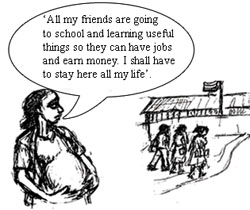
Social impacts of early marriage:
- Disrupts life of the victim
- Limited opportunity for education and employment (see Figure 5.4)
- Higher likelihood of broken marriage
- Rural-urban migration (which may predispose them to prostitution, STIs, HIV and AIDS)
- Stigma, and low self-esteem.
5.2.1 Legal aspects of early marriage
What is the legal age for marriage in Ethiopia? What would you do if you encountered an adolescent girl being married before the legal age for marriage?
In Ethiopia, any marriage arrangement made when either of the couple is underage, and/or without their consent or approval, is illegal and punishable by law. The law forbids the marriage of boys and girls under the age of 18 years. If you become aware that a young girl is going to marry before she turns 18, you need to advise the families that early marriage has many harmful consequences and is against Ethiopian family law. If you can’t contact the families or if they ignore your advice and seem likely to continue with such a marriage you need to notify the appropriate government agencies, including the Office of Women’s Affairs or nearby police, so that early marriage can be prevented and the law is respected.
As you have seen, early marriage is associated with many health and social consequences which could be prevented if the community has sufficient knowledge and the law is enforced.
5.3 Marriage by abduction
Marriage by abduction is the unlawful carrying away of a woman for marriage. It is a form of sexual violence against the woman. The would-be abductor forms a group of intimate friends and relatives to kidnap the girl without the slightest clue or information being given to the girl’s family, relatives or friends. In some cases abduction is followed by rape.
Marriage by abduction is prevalent in Ethiopia. According to a study conducted in 2005 8% of women of reproductive age reported that they had been married by abduction. Figure 5.5 shows that it is more common in Oromia (11%) and SNNPR (13%) but less common in some other region, e.g. Tigray (1.4%), and Amhara (2.4%).
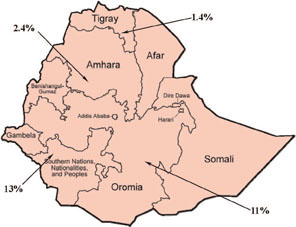
The reasons for marriage by abduction include:
- Refusal or anticipated refusal of consent by the parents or the girl
- To avoid excessive wedding ceremony expenses and ease the economic burden of the conventional bride price
- To outsmart rivals when the girl has many suitors or potential spouses and/or the inclination of the girl or her parents is not predictable
- Difference of economic status of partners.
Some of the harmful effects include:
- Maltreatment of the girl including beating, inflicting bodily harm, severe disabilities and death
- Conflicts between families may lead to quarrels lasting for generations
- Unhappy, unstable and loveless marriage
- Psychological stress on the girl resulting in suicide
- Expenses related to conflict resettlements as compensation to the family or for court cases
- Discontinuation of schooling and other opportunities for the girl.
5.4 Polygamy
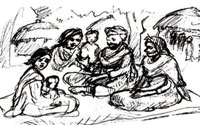
Polygamy is a common practice in Ethiopia. It is a form of marriage in which a person marries more than one spouse. Polygyny (from Greek words: poly = many; gyny = woman) refers to a polygamy in which a man has two or more wives. About 12% of married women in Ethiopia are in polygynous unions (see Figure 5.6). It is usual for a young girl to be married to an older married man.
Who do you think should choose the husband for a young girl: the girl or her parents?
In most rural parts of Ethiopia, girls have no power to choose their husbands. It is usually their parents, particularly their father, who decides who they will marry and the marriage is usually arranged by the parents. It is the legal right of Ethiopian women to choose whom to marry and when to do it. However, their right is not respected and is almost always violated (usually by their parents).
What bad consequences can polygamy have on the sexual and reproductive life of young women?
Polygamy has multiple impacts on the reproductive health and overall life of young women, as you have just learned. It is usually a young woman who is given to a married man. That means the second or third wife is usually younger than the first wife. The young woman usually has less access to resources, little autonomy and no input into family decision making. This exposes her to many health problems including malnutrition of herself and her children. As her husband has multiple sexual partners (i.e. more than one wife), she may be at risk of STIs, including HIV, and then developing AIDS.
5.5 Intervention strategies to minimise and eliminate HTPs
This is obviously a difficult and sensitive subject for you to discuss with people in your community. It may help if you make it widely known that the Ethiopian government and religious leaders, including Islamic and Christian, have taken a lead internationally in condemning HTPs.
When raising awareness who should you target?
Everyone in the community but especially young people, men, community leaders, religious leaders and the women who perform FGM or encourage HTPs.
In particular, you need to work with both Islamic and Christian religious leaders as some of the justifications for practising harmful traditional practices are incorrectly linked to religions. Most religious leaders teach their followers about the position of their religion with regard to such practices which will help your effort in educating your community. It is crucial that you attempt to educate practitioners of HTPs about the dangers of such practices.
You should also mention that the Ethiopian law is against FGM, marriage by abduction and early marriage.
It is important to use educational activities to address the community’s perceptions that there are advantages to practising FGM. This can often be done effectively if you can describe a case study of one of the traditional harmful practices. It is even more effective if a girl who has first hand experience of a HTP is willing to discuss her problems as an example to others.
If people in your community have suffered from HTPs and are willing to talk to you, you can help by listening in a sympathetic and non-judgemental way. There may also be some medical assistance you can offer, but you need to refer them to the next level of facilities for better psychosocial support and medical assistance.
Summary of Study Session 5
In Study Session 5, you have learned that:
- There are both useful (such as breastfeeding; relieving women from work after delivery) and harmful traditional practices in Ethiopia that affect the health of adolescents and youth.
- Among the harmful traditional practices affecting young people in Ethiopia, female genital mutilation (FGM), early marriage, marriage by abduction and polygamy affect reproductive health.
- Communities have reasons for practising some of the harmful traditional practices. Some of the reasons for practising female genital mutilation include sociocultural reasons (such as ensuring girls’ virginity and hence the family’s honour), hygienic and aesthetic reasons (to make girls hygienically clean), spiritual and religious reasons (wrongly believing that it is required by their religion), and psychosexual reasons (to control the sex drive of uncircumcised girls).
- Parents desire early marriage for their daughters so that they can see many grandchildren before they die. Early marriage is also preferred by parents to ensure their daughters are virgins when they marry and hence live up to traditional expectations.
- Harmful traditional practices have multiple negative health consequences for adolescents (and, if they became pregnant, for their children). These consequences range from long- and short-term physical problems such as unwanted pregnancy, severe pain, bleeding and infections, to psychological problems such as mental disorders like depression and social consequences such as limited educational opportunities.
- HTPs and their complications are completely preventable. However, it is not easy to change traditions which have been practised for a long time. Hence, you need to raise awareness not only about the bad consequences of HTPs but also about the legal implications of such practices.
Self-Assessment Questions (SAQs) for Study Session 5
Now that you have completed this study session, you can assess how well you have achieved its Learning Outcomes by answering these questions. Write your answers in your Study Diary and discuss them with your Tutor at the next Study Support Meeting. You can check your answers with the Notes on the Self-Assessment Questions at the end of this Module.
SAQ 5.1 (tests Learning Outcomes 5.1 and 5.2)
Kedija is a 15-year-old girl living with her parents in a rural village. Her father and mother decide she should marry an older merchant in his 50s who lives in the neighbouring town. Her parents are convinced that she would have a better future if she married an older man.
- a.What does Ethiopian law say regarding forced and early marriage?
- b.Does Kedija have the right to say ‘No’ to the suggestions made by her family?
Answer
- a.The Ethiopian family law protects young women’s rights against forced and early marriages (less than 18 years of age).
- b.Since marriage before the age of 18 is illegal in Ethiopia she has the right to say ‘No’ to such a request. As you have learned in Study Session 1 of this Module, young people have the right to expect and demand equality, full consent and mutual respect in sexual relationships.
SAQ 5.2 (tests Learning Outcomes 5.1 and 5.2)
In Case Study 5.2 you read that Emebet was married when she was 15-years-old. Explain how this early marriage caused her harm.
Answer
Emebet has faced many health consequences of early marriage including having a stillbirth and a vesico-vaginal fistula. These complications needed prolonged treatment and when she returned to her village she found her husband had remarried. As a result of being divorced and ill she developed psychosocial problems including feelings of loneliness, isolation and depression.